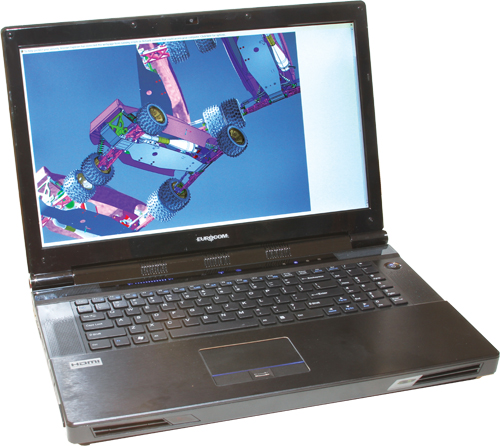Latest News
December 4, 2001
By David Cohn
Eurocom has been building some of the world’s most powerful portable computers for more than 20 years. After putting the company’s impressive D900F Panther system through its paces earlier this year (see DE March 2011), we were quite excited when its successor arrived. And once again we were impressed—the Eurocom Panther 3.0 delivered performance on par with the best desktop workstations. But this time around, we had some concerns with the system’s cooling and power consumption.
Eurocom bills its new Panther 3.0 as a desktop replacement as well as both a server on-the-go and a blazingly fast high-end gaming machine. Built around an Intel X58 chipset, the Panther 3.0 incorporates components typically found only in true workstations, including a top-of-the-line Intel Xeon 6-core CPU, up to four internal hard drives for 3.25TB of storage and as much as 24GB of memory. But all that power comes at a significant price, both economic and ergonomic. The Eurocom Panther 3.0 is expensive, heavy and noisy, and packs a lot into what may be too small a space.

The Eurocom Panther 3.0.
Well, not that small. The Eurocom Panther 3.0 measures 16.5x11.25x3.0 in., and weighs in at 12.25 lbs., plus another 3.5 lbs. for its enormous (8.25x4.5x 2-in.) 300-watt power supply. The system is configured like a traditional notebook computer, with a nicely finished black plastic and brushed aluminum case, but it’s nearly twice as thick as more conventional notebooks. In fact, sitting on a desk, the Panther 3.0 almost looks like it’s resting on top of a second, smaller notebook computer.
Raising the lid reveals a beautiful 17.3-in. Full HD display with a native resolution of 1920x1080 (down from 1920x1200 on the D900F Panther), and a full-size keyboard with a separate numeric keypad. There’s also a touchpad centered below the keyboard with a pair of buttons and a fingerprint reader.
Our evaluation unit came equipped with a 2-megapixel webcam centered above the LCD, flanked by a pair of microphones. Three speakers are located in the hinge below the LCD, with two more in the top corners above the keyboard. Between these are a series of touch sensors for adjusting speaker volume and toggling the Wi-Fi, Bluetooth and webcam on and off, and hard drive and keyboard status indicators. These controls, as well as the large round power button to the right of keyboard, glow bright blue when active.
Configuration Options Galore
The right side of the case provides jacks for audio line-in, S/PDIF-out, microphone-in and headphone, as well as three USB 2.0 ports and a security lock slot. The left side houses a DVI-out port, cable antenna jack (for the systems’ optional TV tuner), RJ-45 LAN jack for the built-in Gigabit Ethernet, HDMI-out port, two USB 3.0 ports, eSATA port, mini-IEEE 1394b (FireWire) port, a 9-in-1 card reader, and the optical device drive bay. There is no provision for a modem, however.
Our evaluation unit came with a Blu-Ray combo drive with 6X Blu-Ray write and 8X DVD+-RW capabilities. The rear of the case contains just the external power connector centered between fan intake vents, while the front includes more air vents as well as a cleverly hidden ExpressCard slot, an infrared receiver (for use with the optional TV tuner) and LED indicators for power and battery.
| Design Engineering Workstations Compared. Download the benchmarks. |
Like most Eurocom systems, configuring the Panther 3.0 is all about choices. The LCD display is available with or without non-glare coatings, and can be driven by a choice of 16 different GPUs, ranging from the NVIDIA GeForce GTX 460M to the top-of-the-line NVIDIA Quadro 5010M installed in our evaluation unit. That graphics accelerator, equipped with 4GB of GDDR5 memory and 384 compute unified device architecture (CUDA) cores, can also power an external 30-in. monitor at up to 2560x1600—but it also adds $2,050 to the cost of the system.
You can configure the Panther 3.0 with any one of 10 different Intel processors. In our case, Eurocom included a 3.46GHz Intel Xeon X5690 CPU with six cores and 12MB of L3 cache. As mentioned, the system can accommodate up to 24GB of memory in three 204-pin small outline dual in-line memory module (SO-DIMM) sockets, which are located beneath the keyboard. While the manual illustrates how to access these sockets, it’s complex enough that most customers will opt to let Eurocom do the work. Our system came equipped with 12GB of memory, using three 4GB DDR3 1600MHz memory modules.
The Panther 3.0 supports up to three standard hard drives (or a fourth if you forego the optical drive), and these are much easier to install. Two mount in a special drive cage within an easily accessible bay on the bottom of the system; the third is located in a separate bay below the battery. Eurocom provided a 250GB Intel solid state hard drive as the primary drive in our evaluation unit, along with a pair of Seagate Momentus 750GB secondary drives. The solid state drive enabled the Panther 3.0 to boot to Windows 7 64-bit in just 50 seconds.
The 78.44WH lithium-ion battery is useful more as an uninterruptable power supply (UPS) rather than for actually powering the system. In fact, you’ll want to get back to AC power or shut the system down quickly when running on battery power, as the battery in our evaluation unit lasted just 38 minutes.
In addition to the poor battery life, the Panther 3.0 also proved to be exceptionally noisy and ran quite hot. Even at idle, the fan noise from the Panther 3.0 was louder than any other device in the office and could be heard from more than 20 ft. away. When running benchmark tests, that noise became even more pronounced, and the air leaving the vents on the rear of the system reached 107 °F.
Performance at a Price
After the results we recorded when testing the previous Eurocom system, we expected to see stellar performance from the Panther 3.0. Expectations were especially high for the SPECviewperf test, which focuses solely on graphics. We got what we had hoped for: The Panther 3.0 outperformed every mobile system we’ve ever reviewed, owing largely to its incredible NVIDIA GPU. In fact, the Panther 3.0’s viewperf results rivaled those of top-of-the-line desktop workstations.
Unfortunately, because the system came with only Windows 7 Professional installed, we were unable to run the SPECapc SolidWorks benchmark. But judging from the performance we experienced when running SolidWorks and other CAD software, we’d definitely expect the Eurocom Panther 3.0 to do an exceptional job on even the most demanding CAD, CAE and DCC tasks.
The results on our AutoCAD rendering test raised some serious concerns, however. With hyper-threading enabled, the equivalent of 12 CPU cores enabled the Panther 3.0 to complete our rendering in as little as 52 seconds—essentially the same as the previously reviewed Eurocom D900F Panther, which had a slightly slower CPU. But in repeated tests, the system averaged 75.5 seconds, and results varied widely. After conferring with Eurocom, the company concluded that it was a power problem and sent us a second 300-watt power supply, along with a small converter box to join the two power supplies together to power the computer. This did improve performance slightly, but consecutive results continued to be somewhat erratic and trended downward.
While rendering each scene, the Panther’s cooling fans became markedly louder. Concluding that there was also a cooling problem, we ran the rendering test manually rather than using a script, waiting several minutes between each rendering until the fans returned to their slowest speed. Sure enough, each rendering now averaged 53.3 seconds, and one iteration took just 49 seconds—a truly impressive result.
That said, all of the Panther’s power comes at a staggering price. The standard Panther 3.0 configuration sells for $2,726. Once we tallied up all of the options included in our evaluation unit, however, the system we received would cost $8,215—with the additional power supply and converter adding another $249 to the price—making it the third-most expensive system we’ve ever reviewed, mobile or desktop.
If that price wasn’t daunting enough, the standard Eurocom warranty only covers the system for one year and requires owners to ship the system back to a factory depot for repairs. Extending the warranty for a second year adds $150 to the cost, while adding a third year adds $268. But Eurocom does offer lifetime upgradability, as well as credits of up to 20% if you trade in an older system when purchasing a new Panther.
While the Eurocom Panther 3.0 is meant to replace desktop workstations for power users on the go, it’s likely to appeal to a very narrow market. The burden in terms of price, weight, power consumption and CPU cooling are serious considerations. If portable performance is your only criteria, the Eurocom Panther 3.0 packs a lot of power, but it may actually be too much power in too small a space.
MORE INFO
Eurocom Corp.
Eurocom Panther 3.0 Mobile Workstation
Price: $8,215 as tested ($2,726 base price)
System requirements:
- Size: 16.5x11.25x3.0-in. (WxDxH) notebook
- Weight: 12.25 lbs. as tested, plus 3.5-lb. power supply
- CPU: 3.46GHz Intel Xeon X5690 6-core w/12MB L3 cache
- Memory: 12GB 1600MHz DDR3 SDRAM (24GB max)
- Graphics: NVIDIA Quadro 5010M with 4GB memory
- LCD: 17.3-in. diagonal (1920x1080)
- Hard Disk: 250GB SSD and two 750GB 7200 rpm Seagate Momentus drives
- Optical: Matshita Multi Blu-ray Disc write and DVD+/-RW dual layer
- Audio: Line-in, SP/DIF-out, microphone, headphone, built-in microphone and speakers
- Network: Integrated Gigabit Ethernet (10/100/1000 NIC); Intel 802.11 a/b/g/n wireless LAN; optional integrated Bluetooth 2.0
- Keyboard: Integrated 98-key keyboard with numeric keypad
- Pointing Device: Integrated 2-button touchpad
- Other: Three USB 2.0, two USB 3.0, one mini IEEE 1394 Firewire, eSATA, Express Card slot, 9-in-1 card reader, DVI-out, HDMI-out, 2MP webcam, CATV. Laptop case included
David Cohn is the technical publishing manager at 4D Technologies and the author of that company’s CADLearning eLearning courses for AutoCAD. He also does consulting and technical writing from his home in Bellingham, WA. He’s a contributing editor to Desktop Engineering and the author of more than a dozen books on AutoCAD, a program that he has used for more than 25 years. Contact him via email at [email protected] or visit his website at DSCohn.com.
Subscribe to our FREE magazine, FREE email newsletters or both!
Latest News
About the Author
David Cohn is a consultant and technical writer based in Bellingham, WA, and has been benchmarking PCs since 1984. He is a Contributing Editor to Digital Engineering, the former senior content manager at 4D Technologies, and the author of more than a dozen books. Email at [email protected] or visit his website at www.dscohn.com.
Follow DE





